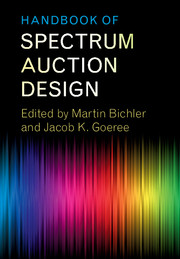Book contents
- Frontmatter
- Contents
- List of Contributors
- Preface
- List of Papers
- Part I The Simultaneous Multiple-Round Auction
- Part II The Combinatorial Clock Auction Designs
- 5 Combinatorial Auction Design
- 6 The Clock-Proxy Auction: A Practical Combinatorial Auction Design
- 7 Spectrum Auction Design
- 8 A Practical Guide to the Combinatorial Clock Auction
- 9 Market Design and the Evolution of the Combinatorial Clock Auction
- 10 Quadratic Core-Selecting Payment Rules for Combinatorial Auctions
- 11 Core-Selecting Package Auctions
- 12 A New Payment Rule for Core-Selecting Package Auctions
- 13 On the Impossibility of Core-Selecting Auctions
- 14 Ascending Combinatorial Auctions with Risk Averse Bidders
- 15 Properties of the Combinatorial Clock Auction
- 16 Budget Constraints in Combinatorial Clock Auctions
- 17 (Un)expected Bidder Behavior in Spectrum Auctions: About Inconsistent Bidding and its Impact on Efficiency in the Combinatorial Clock Auction
- Part III Alternative Auction Designs
- Part IV Experimental Comparisons of Auction Designs
- Part V The Bidders’ Perspective
- Part VI Secondary Markets and Exchanges
- Outlook
- References
17 - (Un)expected Bidder Behavior in Spectrum Auctions: About Inconsistent Bidding and its Impact on Efficiency in the Combinatorial Clock Auction
from Part II - The Combinatorial Clock Auction Designs
Published online by Cambridge University Press: 26 October 2017
- Frontmatter
- Contents
- List of Contributors
- Preface
- List of Papers
- Part I The Simultaneous Multiple-Round Auction
- Part II The Combinatorial Clock Auction Designs
- 5 Combinatorial Auction Design
- 6 The Clock-Proxy Auction: A Practical Combinatorial Auction Design
- 7 Spectrum Auction Design
- 8 A Practical Guide to the Combinatorial Clock Auction
- 9 Market Design and the Evolution of the Combinatorial Clock Auction
- 10 Quadratic Core-Selecting Payment Rules for Combinatorial Auctions
- 11 Core-Selecting Package Auctions
- 12 A New Payment Rule for Core-Selecting Package Auctions
- 13 On the Impossibility of Core-Selecting Auctions
- 14 Ascending Combinatorial Auctions with Risk Averse Bidders
- 15 Properties of the Combinatorial Clock Auction
- 16 Budget Constraints in Combinatorial Clock Auctions
- 17 (Un)expected Bidder Behavior in Spectrum Auctions: About Inconsistent Bidding and its Impact on Efficiency in the Combinatorial Clock Auction
- Part III Alternative Auction Designs
- Part IV Experimental Comparisons of Auction Designs
- Part V The Bidders’ Perspective
- Part VI Secondary Markets and Exchanges
- Outlook
- References
Summary
Introduction
The design of auction protocols and systems has received considerable academic attention in the recent years and found application in industrial procurement, logistics, and in public tenders (Airiau and Sen, 2003; Bellantuono et al., 2013). Spectrum auction design is one of the most challenging and visible applications. It is often seen as a pivotal example for the design of multi-object markets and successful auction designs are likely role-models for other markets in areas such as procurement and logistics.
Efficiency, revenue, and strategic simplicity for bidders are typical design goals that a regulator has in mind. In theory, theVickrey-Clarke-Groves (VCG) auction is the only strategy-proof and efficient auction but for practical reasons, it has rarely been used so far (Rothkopf, 2007). Several other auction formats have been designed and used for selling spectrum. The most prominent example is the Simultaneous Multi-Round Auction (SMRA) which has been used since the mid-90s to sell spectrum licenses world-wide. The more recent Combinatorial Clock Auction (CCA) is a two-phase auction format with an initial ascending clock auction and a sealed-bid supplementary bid phase afterward. It has lately been used to sell spectrum in countries such as Australia, Austria, Canada, Denmark, Ireland, the Netherlands, Slovenia, and the UK.
The CCA draws on a number of elegant ideas inspired by economic theory. A revealed preference activity rule should provide incentives for bidders to bid straightforward or consistent, i.e., to bid truthfully on one of the payoff-maximizing packages in each round of the clock phase. If bidders fail to maximize utility and bid on a package with a less than optimal payoff, we will also refer to this as inconsistent bidding behavior, i.e., bids which are not consistent with the assumption of utility maximization. A second-price rule should set incentives to bid all valuations truthfully in the second sealed-bid phase. It can be shown that if bidders respond to these incentives in both phases of the CCA, then the outcome is efficient and in the core (Ausubel et al., 2006). However, bidders might not have incentives to bid truthful in both phases, and this can lead to inefficiencies.
- Type
- Chapter
- Information
- Handbook of Spectrum Auction Design , pp. 338 - 370Publisher: Cambridge University PressPrint publication year: 2017
References
- 2
- Cited by



